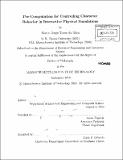Pre-computation for controlling character behavior in interactive physical simulations
Author(s)
Silva, Marco Jorge Tome da
DownloadFull printable version (12.92Mb)
Other Contributors
Massachusetts Institute of Technology. Dept. of Electrical Engineering and Computer Science.
Advisor
Jovan Popović.
Terms of use
Metadata
Show full item recordAbstract
The development of advanced computer animation tools has allowed talented artists to create digital actors, or characters, in films and commercials that move in a plausible and compelling way. In interactive applications, however, the artist does not have total control over the scenarios the character will experience. Unexpected changes in the environment of the character or unexpected interactions with dynamic elements of the virtual world can lead to implausible motions. This work investigates the use of physical simulation to automatically synthesize plausible character motions in interactive applications. We show how to simulate a realistic motion for a humanoid character by creating a feedback controller that tracks a motion capture recording. By applying the right forces at the right time, the controller is able to recover from a range of interesting changes to the environment and unexpected disturbances. Controlling physically simulated humanoid characters is non-trivial as they are governed by non-linear, non-smooth, and high-dimensional equations of motion. We simplify the problem by using a linearized and simplified dynamics model near a reference trajectory. Tracking a reference trajectory is an effective way of getting a character to perform a single task. However, simulated characters need to perform many tasks form a variety of possible configurations. This work also describes a method for combining existing controllers by adding their output forces to perform new tasks. This allows one to reuse existing controllers. A surprising fact is that combined controllers can perform optimally under certain conditions. These methods allow us to interactively simulate many interesting humanoid character behaviors in two and three dimensions. These characters have many more degrees of freedom than typical robot systems and move much more naturally. Simulation is fast enough that the controllers could soon be used to animate characters in interactive games. It is also possible that these simulations could be used to test robotic designs and biomechanical hypotheses.
Description
Thesis (Ph. D.)--Massachusetts Institute of Technology, Dept. of Electrical Engineering and Computer Science, 2010. Cataloged from PDF version of thesis. Includes bibliographical references (p. 129-136).
Date issued
2010Department
Massachusetts Institute of Technology. Department of Electrical Engineering and Computer SciencePublisher
Massachusetts Institute of Technology
Keywords
Electrical Engineering and Computer Science.